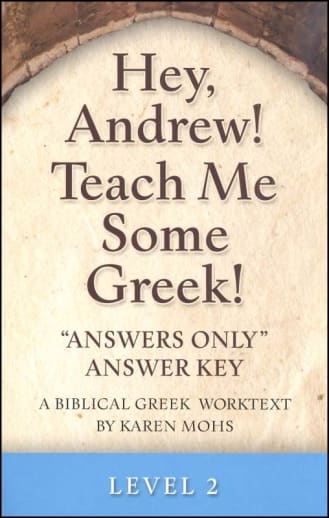- Biblical Greek
- The "Answers Only" key is a small booklet referencing the workbook page numbers and the answers that belong on each page.
Hey, Andrew! Teach Me Some Greek Level 2 Answers Only Key
Description
The Hey, Andrew! Teach Me Some Greek series of workbooks teaches koine Greek using a combination of deductive, inductive, and interactive methodology. Its main goal is to equip students to study the Greek New Testament for themselves, so they can identify inaccurate theology based on faulty Biblical interpretations. But it's also worthwhile to pursue for expanding vocabulary, since many English words have Greek roots. Below is an overview of what topics are covered at each course level.
- Level 1 teaches the 24 letters of the Greek alphabet in its Reader. The companion workbook reinforces the learning, including a variety of activity pages (matching, dot-to-dot, puzzles). Students below fourth grade should start at this level.
- Level 2 begins using the Greek alphabet to form words. Eleven vocabulary words lay the foundation for grammar to be introduced in Level Three. The workbook contains a review of the alphabet, Greek words to read and write, and a variety of puzzles and activity pages.
- Level 3 begins to incorporate grammar, introducing noun and verb inflections, including second declension nouns and present active verbs. Students begin to translate Greek to English and English to Greek. The workbook reviews alphabet and vocabulary from previous levels, so upper senior high and adult students can begin here.
- Level 4 continues with the first declension and the articles, incorporating these new skills into the translation of Greek sentences. The workbook reviews learning from previous levels, and teaches articles, accents, feminine nouns, and word order. As with other levels, it also contains activity pages to help make the learning fun.
- Level 5 adds adjectives, prepositions, and adverbs.
- Level 6 introduces imperfect and future indicative, middle/passive voice, personal pronouns, enclitics, deponents, and continues to expand vocabulary.
- Level 7 helps students perfect their Greek skills as they learn additional pronouns, work on language proficiency in all tenses and voices, expand their vocabulary, and work on translating the first two chapters of I John. According to the author, completing the first seven levels of the program is roughly equivalent to three credits of high school Greek.
- Level 8 covers subjunctive and imperative mood, irregular adjectives, comparison of adjectives and adverbs and more while continuing to translate and write Greek sentences and translating II John and III John.
Because of the gentle introduction and incremental learning, this series is excellent for teaching Biblical Greek without prior experience with the language. According to the author, completing the first seven levels of the program is equivalent to 3 credits of high school Greek.
| Product Format: | Softcover Book |
|---|---|
| Grades: | 2-AD |
| Brand: | Greek 'n' Stuff |
| Author: | Karen Mohs |
| ISBN: | 9781931842082 |
| Length in Inches: | 8.5 |
| Width in Inches: | 5.5 |
| Height in Inches: | 0.125 |
| Weight in Pounds: | 0.125 |
| Ages: | 6+ |
| Edition: | Teacher's Guide |
| Pages: | 12 |
| Publication Date: | 1996 |

